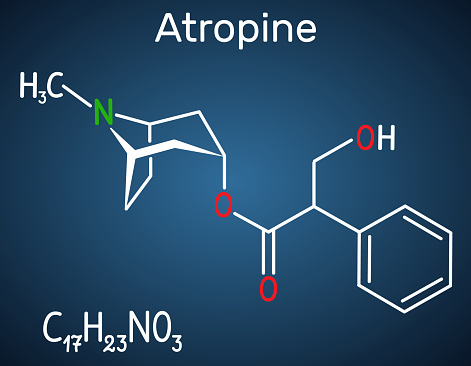
Atropine drug molecule. It is plant alkaloid. Structural chemical formula on the dark blue background. Vector illustration
August 9, 2019
By Praveen Bandela
PhD student, Brien Holden Vision Institute
Various optical and pharmaceutical approaches have been proposed and shown to have positive results in retarding the progression of myopia. In this retrospective study, the authors investigated if the combination of optical (ortho-k lenses) and pharmaceutical (0.01% atropine) approaches have any benefit over individual treatment paradigms.
This study had two phases. Children under 12 years old with refractive error ranging from -1.00D to -5.00D were included in phase one of the study. Upon a successive comprehensive ophthalmic examination, they were fitted with ortho-k lenses in both eyes. Axial length (AL) was measured at baseline and every six months after the ortho-k lens wear. Participants who had 0.25mm/year axial length change were recruited in phase two of the study. The participants were prescribed low-dose atropine (0.01%) applied once per night, 30 minutes before ortho-k lens insertion. AL measurements were repeated every six months after the atropine use. In a previous study by the authors, 64 subjects completed the two-year study in which they were treated with ortho-k lenses only (no atropine use). Twenty-nine out of the 64 subjects had axial elongation of 0.25mm or greater in the first year and were identified as the control group for this study.
The participants (n=60) had a baseline spherical equivalent refractive error (SERE) and AL of −2.65 ± 1.08D and 24.34 ± 0.92mm, respectively. After the first year of ortho-k treatment, the mean AL increased to 24.80 ± 0.87 mm, with a mean axial growth of 0.46 ± 0.16 mm. Axial elongation rate was significantly correlated with baseline age, being much faster in younger children as compared to the elder group. After one year of combined treatment of ortho-k and atropine, AL increased from 24.80 ± 0.87mm to 24.94 ± 0.88mm, with a mean axial growth of 0.14 ± 0.14mm. The rate of axial was much slower in phase two than phase one of the study (t=−11.988, P < 0.001). Reduction in axial elongation rate during phase two was more significant in children who experienced faster axial growth in phase one but was not correlated to baseline age or SERE.
This retrospective analysis concluded that the addition of low dose atropine to the ortho-k treatment paradigm does decline the rate of myopia progression. However, optimal treatment duration and ideal starting age remain unclear. Further clinical studies are warranted to elucidate these issues.
ABSTRACT
Chen Z, Huang S, Zhou J, Xiaomei Q, Zhou X, Xue F.
PURPOSE: To investigate the adjunctive effect of orthokeratology (ortho-k) and low-dose atropine eye drops on axial length elongation in fast-progressing myopic children.
METHODS: Axial elongation in 60 eyes of 60 subjects who completed two years of ortho-k treatment was retrospectively reviewed. They were aged between 5.6-11.6 (mean, 8.3 ± 1.5) years old when they started ortho-k treatment. During their first year of ortho-k treatment (Phase One), they all demonstrated a faster than 0.25 mm/yr axial elongation rate. They were then treated with nightly 0.01% atropine in addition to ortho-k treatment for another year (Phase Two). Annual axial elongation rates before and after atropine treatment were compared.
RESULTS: Baseline spherical equivalent refractive error was -2.65 ± 1.08 DS, and axial length was 24.34 ± 0.92 mm for the study cohort. The mean axial elongation rate was 0.46 ± 0.16 mm/yr during Phase One, being significantly faster in younger children (t = -4.920, P < 0.001). When atropine was added, annual axial elongation rate significantly decreased to 0.14 ± 0.14 mm/yr (t = -11.988, P < 0.001), and those who were fast progressors in Phase One had a greater reduction in the rate of axial elongation during Phase Two (t = -8.052, P < 0.001).
CONCLUSIONS: Axial elongation rate is faster in younger children undergoing ortho-k treatment. For fast myopia progressors, low dose atropine may significantly slow axial elongation in addition to ortho-k’s treatment effect. Those who have faster axial elongation after ortho-k treatment will benefit more from the addition of low dose atropine, regardless of their refractive error and age.
Chen, Z., Huang, S., Zhou, J., Xiaomei, Q., Zhou, X., & Xue, F. (2019). Adjunctive effect of orthokeratology and low dose atropine on axial elongation in fast-progressing myopic children—A preliminary retrospective study. Contact Lens and Anterior Eye, 42(4), 439-442.













